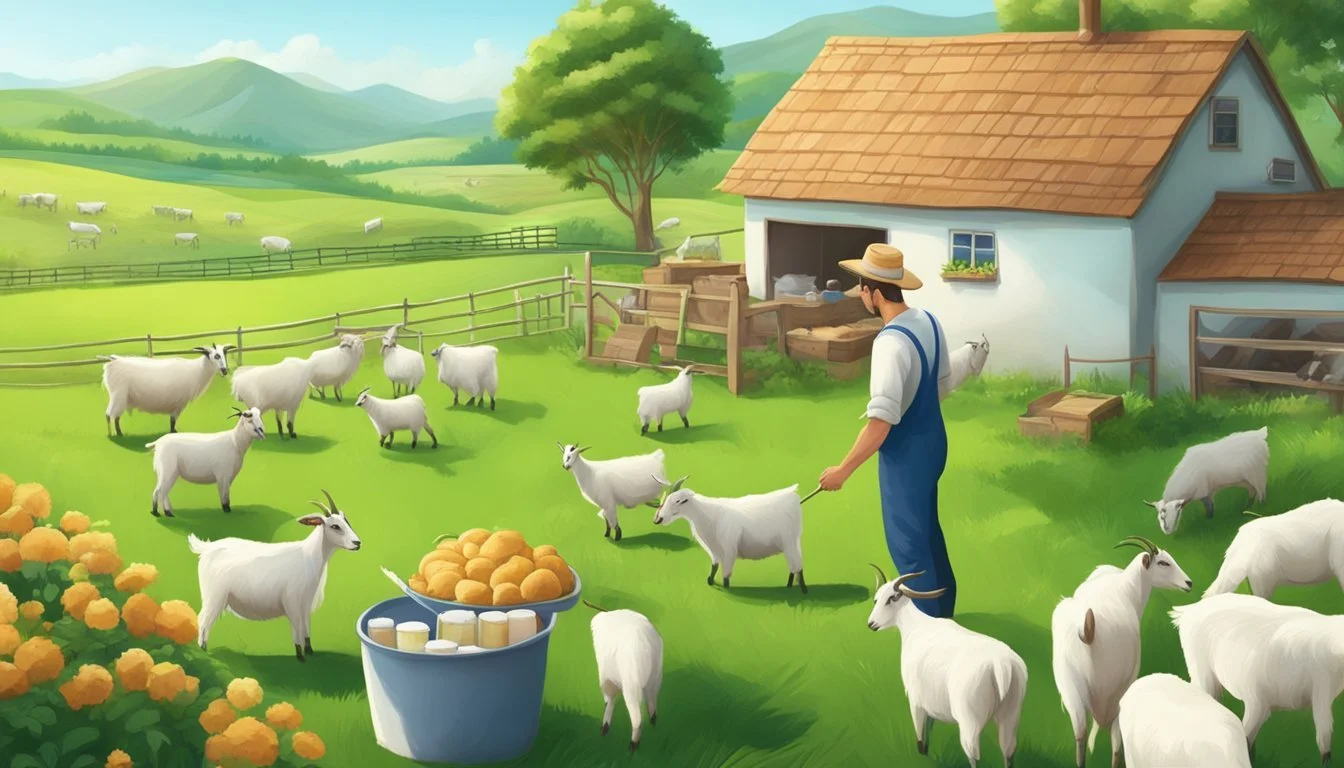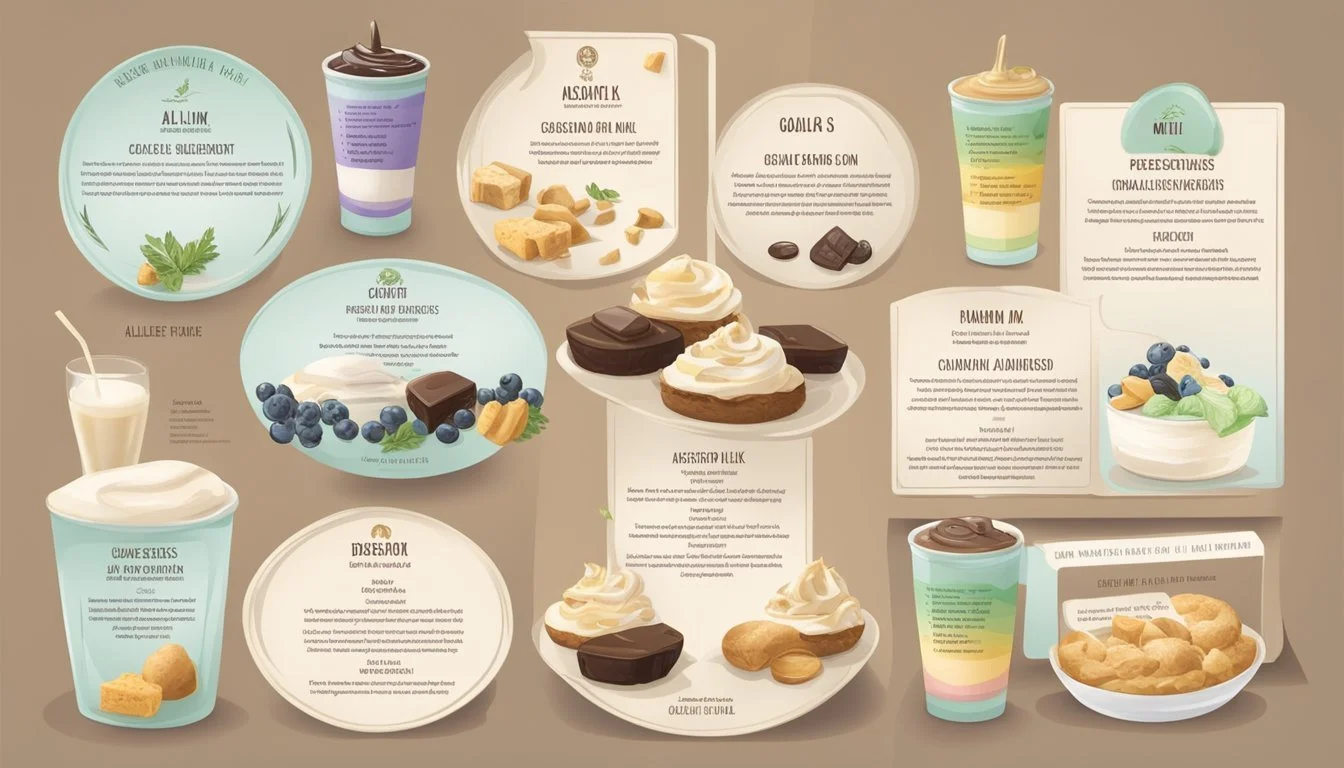How to Create a Goat Milk Dessert Menu
Curating Sweet Treats for Your Home Café
Creating an exceptional dessert menu that features goat milk is a smart move for any home café looking to offer unique and delicious treats. Goat milk is not only sought after for its richer flavor compared to cow's milk but also for being easier to digest, making it an excellent base for a variety of desserts (What wine goes well with desserts?). By incorporating this versatile ingredient, a home café can cater to diverse palates and dietary preferences with a touch of culinary innovation.
Crafting a menu around goat milk desserts invites an exploration of traditional and modern recipes. Whether it’s the creamy subtlety of a classic goat milk custard or the luscious sweetness of cajeta, a type of goat's milk caramel, the depth of flavor goat milk provides can be a game-changer for even the simplest of desserts. Not only does it enrich the taste profile, but also enhances the overall texture, elevating the dining experience for customers.
Moreover, goat milk can be the foundation for a range of diverse desserts, from classic to innovative. A home café may feature anything from cheesecakes and ice creams to panna cottas and flans, all made with the distinctive goodness of goat milk. Adding dessert dishes made of goat milk can attract clientele looking for a gourmet café experience while providing a healthier alternative to traditional dessert ingredients.
Understanding Goat Milk in Desserts
Incorporating goat milk into desserts can enrich the flavor profile and provide a distinct nutritional value. Here's a closer look at its role in sweet culinary creations.
Nutritional Value
Goat milk offers a myriad of nutrients that are beneficial to health, making it a worthy addition to dessert menus. It is a good source of proteins, important vitamins such as Vitamin A and B2 (Riboflavin), and contains less lactose compared to cow's milk, which can make it easier to digest for some individuals. A 240 ml (8 oz) serving of goat milk typically contains:
Calories: 168
Protein: 8.7 grams
Fat: 10 grams
Calcium: 327 mg
Vitamin A: 483 IU
Vitamin B2 (Riboflavin): 0.3 mg
These nutrients contribute to the overall nutritional value of desserts, offering more than just a sweet taste.
Flavor Profile
Goat milk imparts a unique flavor profile to desserts. It has a slightly sweet and sometimes earthy taste, which is more pronounced than the milder flavor of cow's milk. This distinctive taste can elevate traditional desserts with a novel twist. Goat milk harmonizes particularly well with bold ingredients like honey and cinnamon, creating complex and rich flavor combinations.
Its fresh, dairy quality acts as an excellent base for creamy desserts (What wine goes well with creamy desserts?) such as custards, cheeses, and ice creams, complementing the textures and flavors of these dishes. Additionally, goat milk's consistency allows it to blend smoothly into recipes, ensuring that desserts are exquisitely balanced both in taste and texture.
Key Ingredients for Goat Milk Desserts
Creating exquisite goat milk desserts requires a careful selection of key ingredients that enrich flavor, texture, and sweetness. High-quality dairy elements, complementary sweeteners, and specific flavor enhancers play crucial roles in achieving the perfect dessert.
Sweetening Goat Milk
Sweeteners are vital in balancing the distinct taste of goat milk. Popular choices include:
Sugar: A classic sweetener that dissolves easily. Its use is demonstrated in the process of making Cajeta, a goat's milk dulce de leche.
Honey: Adds a natural, rich sweetness.
Brown Sugar: Provides a deeper, caramel-like flavor.
Sweetened Condensed Milk: Often used for its creamy texture and sweet taste.
Piloncillo: A raw form of cane sugar with a molasses flavor; ideal for authentic recipes like Homemade Cajeta.
Thickening Agents
To achieve the desired consistency in goat milk desserts, thickening agents are essential. These include:
Cornstarch: A gluten-free alternative that thickens without altering flavor.
Eggs: Particularly egg yolks, which add richness and aid in custard formation as seen in Vanilla Goat Milk Custard.
Flour: Often used in baked goods for structure and stability.
Enhancing Flavors
Flavor enhancers are used to elevate the taste profile of goat milk desserts. Some key enhancers consist of:
Vanilla Extract: A common choice for a warm, classic flavor.
Cinnamon Stick: Imparts a warm spice, essential in traditional cajeta recipes.
Sea Salt: Balances sweetness and can bring out complex flavors, particularly in caramels like Goat Milk Caramels.
Rum or Vanilla Bean: For a more sophisticated and complex flavor profile, often used in premium desserts.
Butter and Cream: Indispensable fats that contribute to richness and mouthfeel, fundamental in desserts such as caramels and custards.
Preparation Techniques
Creating a goat milk dessert menu requires precision and understanding of how goat milk interacts with other ingredients during the preparation process. Following specific techniques will ensure that every dessert not only tastes delightful but also reflects the unique qualities of goat milk.
General Baking Tips
When incorporating goat milk into baked desserts, ensure that all ingredients are at room temperature to enable better incorporation. Goat milk has a tendency to curdle, so one must take care to sift dry ingredients like baking powder to ensure uniformity. Refrigerate this milk before using, as it helps in maintaining its structure especially when whipping it for fluffiness. For cookies or delicate crusts, use a baking sheet lined with parchment to prevent sticking and achieve a uniformly baked bottom.
Recipe steps should be meticulously followed, with particular attention given to mixing techniques to prevent the overdevelopment of gluten which can lead to tough textures. Baking times may slightly differ due to the liquid dynamics of goat milk, so it is recommended to check the doneness several minutes before the recipe suggests.
Cooking on Stovetop
Use a saucepan when you want to create sauces or fillings that include goat milk. Stirring often and using medium-high heat are keys to prevent scorching the milk. Bring mixtures to a simmer rather than a full boil to avoid curdling. When a recipe involves tempering eggs with goat milk, it's important to maintain a consistent temperature to ensure a smooth, creamy consistency.
If the dessert requires a chilled element, like panna cotta or mousse, let the preparation cool slightly before refrigerating. This helps to prevent a skin from forming on the surface. Remember to portion the desserts into their serving vessels before they set, to avoid any unnecessary manipulation that could affect the final texture.
Signature Goat Milk Dessert Recipes
Creating a goat milk dessert menu can enhance the uniqueness of any home café with rich, distinctive flavors. These signature recipes showcase the versatility of goat milk as a primary ingredient, from creamy ice creams to decadent caramels and rustic cakes.
Goat Milk Ice Cream
A classic favorite, Goat Milk Ice Cream stands out with its creamy texture and delicious tang. Key ingredients include goat milk, granulated sugar, and vanilla extract. Begin by whisking sugar and egg yolks until well blended, then slowly incorporate chilled goat milk and vanilla. Once the mixture thickens on the stove, refrigerate until cold. Churn in an ice cream maker until it reaches the perfect consistency. For variations, add fresh berries or a swirl of goat milk cajeta to the base recipe.
Cajeta and Dulce de Leche
The indulgence of Cajeta and Dulce de Leche, made with sweetened caramelized goat milk, is hard to resist. This topping and spread are crafted by simmering goat milk with sugar, a touch of baking soda, and vanilla extract to achieve a rich, golden brown concoction. The mixture is stirred frequently over a couple of hours until it thickens and deepens in color. Serve it warm over ice cream or as a filling between cake layers. These treats pair well with spices such as cinnamon, offering numerous variations.
Rustic Goat Milk Cakes
Easy to prepare and universally beloved, Rustic Goat Milk Cakes imbue subtle goat milk tones into every slice. The cake batter combines goat milk with flour, sugar, and cream, leavened with baking soda for lightness. Once baked to a golden hue, these cakes can be enjoyed plain or adorned with toppings like fruit compotes or whipped cajeta frosting. Serving these cakes with a scoop of goat milk ice cream is an excellent way to present a comprehensive goat milk dessert experience.
Creative Presentation Ideas
The essence of an exceptional dessert menu lies in the presentation. Beyond the taste, visual appeal can turn simple goat milk desserts into memorable experiences for guests.
Plating Desserts
When plating desserts, chefs often emphasize the contrast of colors and the balance of elements on the plate. Each serving must be a feast for the eyes before it can be a delight to the palate. Utilizing goat milk's inherent creaminess, a dessert plate might feature soft swirls or quenelles of ice cream, artfully drizzled with chocolate or caramel sauce. Alternatively, a layered parfait could exhibit the sheer beauty of different textures, with bold toppings like toasted nuts (What wine goes well with nuts?) or fresh berries that add to the visual drama.
Tips for Plating:
Use white or solid-colored plates to make the dessert stand out.
Incorporate a small assortment of edible flowers for a pop of color.
Pairing with Beverages
Pairing desserts with the right beverage can elevate the overall dessert experience. Since goat milk dessert menus often feature rich, creamy textures, they pair well with beverages that have a contrasting note. For instance, the boldness of a well-brewed coffee can cut through the sweetness and creaminess, creating a harmonious balance. On the other hand, a light and sparkling drink could cleanse the palate between bites.
Beverage Ideas:
Espresso Shots: Offer a bold, concentrated coffee with a creamy dessert to balance flavors.
Herbal Teas: Suggest light, floral teas for a refreshing counterpoint to a rich serving of dessert.
Storing and Making Ahead
When planning a goat milk dessert menu for a home café, understanding the storage techniques for both refrigeration and freezing is crucial. These methods will ensure the quality and freshness of your desserts while allowing you to prepare dishes in advance.
Refrigeration Best Practices
Refrigeration is key in preserving the freshness of goat milk desserts. Goat milk should be stored on a specific shelf in the fridge to avoid cross-contamination and should be kept in an airtight container to maintain freshness. For desserts such as panna cotta or mousse that incorporate goat milk or cream, individual servings should be refrigerated for at least 2 to 4 hours to set properly before serving.
Choosing the Right Containers: Only use containers that provide an airtight seal to prevent the goat milk from absorbing other flavors in the fridge.
Temperature Matters: Keep the fridge temperature consistently at or below 40°F (4°C) to preserve the integrity of the desserts.
Freezing for Longer Shelf Life
Freezing extends the shelf life of your goat milk desserts and is perfect for make-ahead items like ice cream or semifreddo. When freezing, leave enough space for the dessert to expand. Wrap items tightly or use an airtight container to protect against freezer burn and maintain optimal texture upon thawing.
Ice Cream Storage: After churning, store goat milk ice cream in an airtight container and freeze it quickly to prevent ice crystal formation, which affects the creamy texture.
Prevent Freezer Burn: Minimize the air space in containers, especially when storing creamy desserts, to avoid freezer burn and flavor alteration.
Using these storing strategies, one can confidently prepare and preserve goat milk desserts, ensuring that every serving presented to guests meets the highest standards of taste and quality.
Pairing Desserts with Seasons
When designing a goat milk dessert menu for a home café, one must consider the seasonal availability of ingredients and the warmth or coolness desired in a dessert. The right pairing capitalizes on the freshest fruits in summer and the comforting indulgence of richer, warmer desserts in winter.
Summer Treats
During summer, desserts should be light and refreshing. For this season, one can serve goat milk ice cream with a variety of toppings. A favorite combination is a scoop of ice cream paired with fresh, sliced peaches or berries, which are at their peak. Another summer delight could include a tangy goat milk sorbet. For an added touch of elegance, one might drizzle a bit of thin goat milk caramel sauce over the top of the ice cream or sorbet.
Suggested Summer Pairings:
Vanilla Goat Milk Ice Cream with Fresh Strawberries
Lemon Goat Milk Sorbet with Blueberry Compote
Wintertime Comforts
Winter calls for desserts that provide a sense of warmth and comfort. A mug of goat milk hot chocolate, topped with a homemade marshmallow, offers a creamy and soothing treat on a cold day. Desserts like warm apple crisps or pies can be elevated by serving them with a side of goat milk caramel sauce, adding a luxurious richness to the dish.
Suggested Winter Pairings:
Warm Apple Crisp with Goat Milk Caramel Sauce
Rich Goat Milk Hot Chocolate with Cinnamon Stick
Goat Milk Dessert Nutrition and Allergies
When considering goat milk dessert options for a home café, understanding the nutritional value of goat milk and how it interacts with common dietary restrictions and allergies is crucial. This ensures that offerings are both appealing and suitable for a wide range of customers.
Dietary Considerations
Goat milk provides a noteworthy alternative in desserts for those with sensitivities to cow's milk because its protein structure is different, which may be easier for some people to digest. It is important to provide guests with the nutritional information of desserts that include goat milk, as it is still a dairy product and contains lactose, although in lower amounts than cow's milk.
Nutrients: Goat milk is a good source of essential nutrients such as calcium, potassium, and vitamin A.
Protein: On average, goat milk contains slightly less protein per serving compared to cow's milk.
Fat: Goat milk has a comparable fat content, which can contribute to the creaminess of desserts.
Calories: Desserts made with goat milk may have a similar caloric value to those made with cow's milk, depending on the other ingredients used.
Offering an assortment of goat milk-based desserts caters to those looking for a rich, creamy taste in their sweets while possibly being gentler on the stomach. However, it's imperative to clearly communicate that these desserts are still dairy-based.
Balancing Indulgence and Health
Creating a goat milk dessert menu involves striking a balance between indulgence and health. The natural sweetness of goat milk means that recipes can often use less sugar, delivering a subtle sweetness without overloading on added sugars.
Sweets: Consider using natural sweeteners like honey or maple syrup as they can complement the distinct flavor of goat milk.
Flavors: Pure vanilla extract enhances the dessert without adding unnecessary sugar or calories.
Salt: A pinch of salt can heighten the perception of sweetness and enrich flavor profiles without demanding additional sweeteners.
While desserts are typically an indulgence, they can still fit into a healthy lifestyle when portion size and ingredients are thoughtfully managed. For instance, a small, richly flavored goat milk custard or ice cream can be satisfying without being overly decadent.
In crafting a goat milk dessert menu, always regard the possibilities of allergies. While some individuals can tolerate goat milk better than cow's milk, others might be allergic to all types of dairy. Ensure potential allergens are labeled clearly on the menu to provide a safe experience for all customers.










